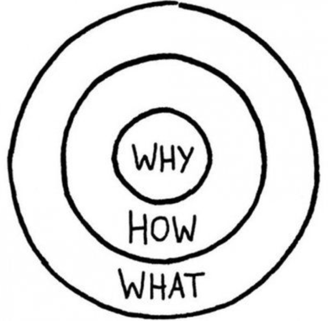
Starting with WHY?
In the book, InSideOut Coaching, one of the four big questions Joe Ehrmann asks is “why do you coach”? Knowing why we are leaders and coaches in high school sports is fundamental to being an InSideOut leader. Too often, many of us are guilty of not reflecting on the reasons why we do something. We know what we do as coaches and sports leaders, but the answer to why just barely scratches the surface. To change the win-at-all-costs sports culture that pervades youth sports, this needs to change.
 Simon Sinek gives insight to help frame how the majority of people behave and communicates. Most of us can explain what we do, some are quickly able to describe how we do it, but few of us can put our finger on why we do what we do. It’s like asking why you are married to someone or why you love another person. You know it feels right, but the words to describe this feeling can be hard to capture.
Simon Sinek gives insight to help frame how the majority of people behave and communicates. Most of us can explain what we do, some are quickly able to describe how we do it, but few of us can put our finger on why we do what we do. It’s like asking why you are married to someone or why you love another person. You know it feels right, but the words to describe this feeling can be hard to capture.
In his book, Start with Why, Sinek identifies the interplay between what, how, and why as the Golden Circle. Since what we do is easiest to describe, this is where most people and organizations begin. They start where their vision is the clearest and then they move into the circle, where their vision is fuzzier. The tendency is to explain what is the result of actions and then how the actions are taken to realize a belief. Sometimes revealing why, and sometimes not.
Inspired leaders flip this around. They think, act, and communicate from the inside out, starting with why and moving out from there. They don’t start with what they do, they begin with their purpose, their cause, their beliefs. It’s not only asking what is important, but it is also answering why it is important. People don’t buy what you do – they buy why you do it.
Sinek uses Apple Inc. as a gold standard for inside-out thinking and communication. What sets Apple apart is its way of thinking. If they were not the creative, purpose-led, innovative company they are, and started from the outside-in, Sinek explains their messaging might look like this:
We make great computers (what). They are beautifully designed, simple to use, and user-friendly (how). Want to buy one (lack of much of a why)?
Alternately, Sinek illustrates what Apple’s why-first message looks like:
In everything we do, we believe in challenging the status quo, we believe in thinking differently (why). The way we do this is by making our products beautifully designed, simple to use, and user-friendly (how). We just happen to make great computers – want to buy one (what)?
Starting with why is not a concept exclusive to Fortune 500 companies. It is vitally important for youth sports leaders. We know what we do, but how much time have we spent communicating why? A conversation around the Golden Circle applied to your sports setting would be a great individual or collaborative activity for any athletics department. It may even provide clarity to allow you to travel from flat to inspired. And, the activity is simple. Here’s a comparison at what starting with what versus why looks like for me.
Starting with What:
Providing educational athletics opportunities (what) by leading student experiences focused on both physical and moral development (how) because sports can make the world better (why).
Starting with Why
Sports have the potential to change the world for better, making better people – not just better athletes – (why) by providing transformational student experiences focused on both physical and moral development (how) through educational-athletics opportunities (what)!
So, where do you start? As a transformational leader, you love what you do. Can you explain why, or what your true purpose is? An integral part of your InSideOut journey is to let your purpose and why lead you through the sea of whats.... be sure to spend the needed time to reflect and create your own transformational purpose statement. Then, share your WHY with anyone who will listen!
